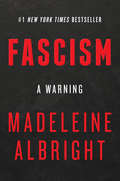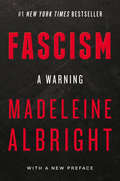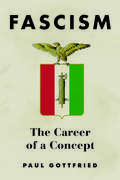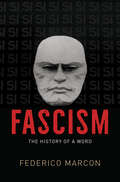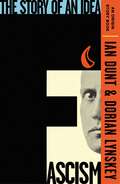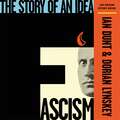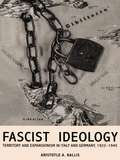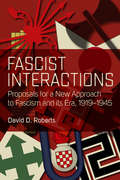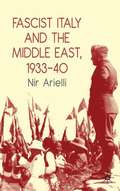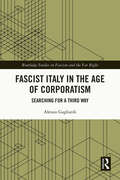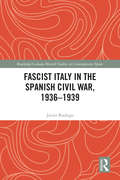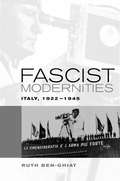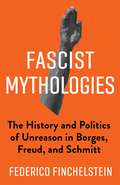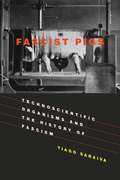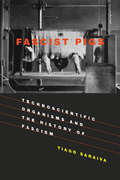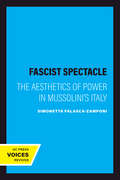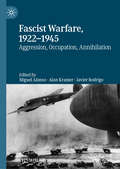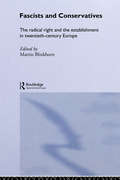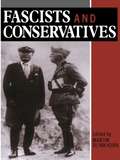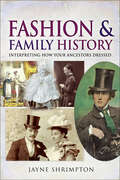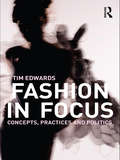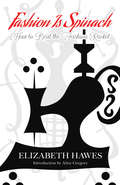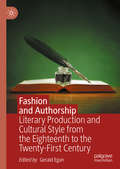- Table View
- List View
Fascism: A Warning
by Madeleine Albright<P>A personal and urgent examination of Fascism in the twentieth century and how its legacy shapes today’s world, written by one of America’s most admired public servants, the first woman to serve as U.S. secretary of stateA Fascist, observes Madeleine Albright, “is someone who claims to speak for a whole nation or group, is utterly unconcerned with the rights of others, and is willing to use violence and whatever other means are necessary to achieve the goals he or she might have.” <P>The twentieth century was defined by the clash between democracy and Fascism, a struggle that created uncertainty about the survival of human freedom and left millions dead. Given the horrors of that experience, one might expect the world to reject the spiritual successors to Hitler and Mussolini should they arise in our era. <P>In Fascism: A Warning, Madeleine Albright draws on her experiences as a child in war-torn Europe and her distinguished career as a diplomat to question that assumption.Fascism, as she shows, not only endured through the twentieth century but now presents a more virulent threat to peace and justice than at any time since the end of World War II. <P>The momentum toward democracy that swept the world when the Berlin Wall fell has gone into reverse. The United States, which historically championed the free world, is led by a president who exacerbates division and heaps scorn on democratic institutions. In many countries, economic, technological, and cultural factors are weakening the political center and empowering the extremes of right and left. Contemporary leaders such as Vladimir Putin and Kim Jong-un are employing many of the tactics used by Fascists in the 1920s and 30s. <P>Fascism: A Warning is a book for our times that is relevant to all times. Written by someone who has not only studied history but helped to shape it, this call to arms teaches us the lessons we must understand and the questions we must answer if we are to save ourselves from repeating the tragic errors of the past. <P><b>A New York Times Bestseller</b>
Fascism: A Warning
by Madeleine Albright#1 New York Times Bestseller Best Books of 2018 --The EconomistA personal and urgent examination of Fascism in the twentieth century and how its legacy shapes today’s world, written by one of America’s most admired public servants, the first woman to serve as U.S. secretary of stateA Fascist, observes Madeleine Albright, “is someone who claims to speak for a whole nation or group, is utterly unconcerned with the rights of others, and is willing to use violence and whatever other means are necessary to achieve the goals he or she might have.” The twentieth century was defined by the clash between democracy and Fascism, a struggle that created uncertainty about the survival of human freedom and left millions dead. Given the horrors of that experience, one might expect the world to reject the spiritual successors to Hitler and Mussolini should they arise in our era. In Fascism: A Warning, Madeleine Albright draws on her experiences as a child in war-torn Europe and her distinguished career as a diplomat to question that assumption.Fascism, as she shows, not only endured through the twentieth century but now presents a more virulent threat to peace and justice than at any time since the end of World War II. The momentum toward democracy that swept the world when the Berlin Wall fell has gone into reverse. The United States, which historically championed the free world, is led by a president who exacerbates division and heaps scorn on democratic institutions. In many countries, economic, technological, and cultural factors are weakening the political center and empowering the extremes of right and left. Contemporary leaders such as Vladimir Putin and Kim Jong-un are employing many of the tactics used by Fascists in the 1920s and 30s.Fascism: A Warning is a book for our times that is relevant to all times. Written by someone who has not only studied history but helped to shape it, this call to arms teaches us the lessons we must understand and the questions we must answer if we are to save ourselves from repeating the tragic errors of the past.
Fascism: The Career of a Concept
by Paul GottfriedWhat does it mean to label someone a fascist? Today, it is equated with denouncing him or her as a Nazi. But as intellectual historian Paul E. Gottfried writes in this provocative yet even-handed study, the term's meaning has evolved over the years. Gottfried examines the semantic twists and turns the term has endured since the 1930s and traces the word's polemical function within the context of present ideological struggles. Like "conservatism," "liberalism," and other words whose meanings have changed with time, "fascism" has been used arbitrarily over the years and now stands for a host of iniquities that progressives, multiculturalists, and libertarians oppose, even if they offer no single, coherent account of the historic evil they condemn. Certain factors have contributed to the term's imprecise usage, Gottfried writes, including the equation of all fascisms with Nazism and Hitler, as well as the rise of a post-Marxist left that expresses predominantly cultural opposition to bourgeois society and its Christian and/or national components. Those who stand in the way of social change are dismissed as "fascist," he contends, an epithet that is no longer associated with state corporatism and other features of fascism that were once essential but are now widely ignored. Gottfried outlines the specific historical meaning of the term and argues that it should not be used indiscriminately to describe those who hold unpopular opinions. His important study will appeal to political scientists, intellectual historians, and general readers interested in politics and history.
Fascism: The History of a Word (The Life of Ideas)
by Federico MarconA wide-ranging history of the term “fascism,” what it has meant, and what it means today. The rise and popular support for authoritarianism around the world and within traditional democracies have spurred debates over the meaning of the term “fascist” and when and whether it is appropriate to use it. The landmark study Fascism: The History of a Word takes this debate further by tackling its most fundamental questions: How did the terms “fascism” and “fascist” come to be in the first place? How and in what circumstances have they been used? How can they be understood today? And what are the advantages (or disadvantages) of using “fascism” to make sense of interwar authoritarianism as well as contemporary politics? Exploring the writings and deeds of political leaders, activists, artists, authors, and philosophers, Federico Marcon traces the history of the term’s use (and usefulness) in relation to Mussolini’s political regime, antifascist resistance, and the quest of postwar historians to develop a definition of a “fascist minimum.” This investigation of the semiotics of “fascism” also aims to inquire about people’s voluntary renunciation of the modern emancipatory ideals of freedom, equality, and solidarity.
Fascism: The Story of an Idea (An Origin Story Book) (An Origin Story Book)
by Dorian Lynskey Ian DuntAN ORIGIN STORY BOOK'Provides clarity, scholarship, wit and essential insight into why our world is the way it is' Adam Rutherford'I wish I could make Ian and Dorian's work mandatory' Sathnam SangheraWhy is 'fascist' used to describe everyone from dictators to parking wardens? Does the word 'fascism' describe a historical movement or an enduring ideology? And could we see it rise again today, in an age of populism?Unlike most major political ideologies, fascism has no clear-cut intellectual foundation. It appeals to some of the very darkest instincts in human nature: the hatred of difference, the desire to control, the delight in violence. The story of fascism shows us what happens when these instincts consume entire nations.In Fascism: The Story of an Idea, Ian Dunt and Dorian Lynskey lay out in clear and accessible terms the origins of fascism: what happened, how it happened and why. It is only by understanding fascism's beginnings that we can start to understand what it means today - and guard against those who seek its return.
Fascism: The Story of an Idea (An Origin Story Book) (An Origin Story Book)
by Dorian Lynskey Ian DuntAN ORIGIN STORY BOOK'Provides clarity, scholarship, wit and essential insight into why our world is the way it is' Adam Rutherford'I wish I could make Ian and Dorian's work mandatory' Sathnam SangheraWhy is 'fascist' used to describe everyone from dictators to parking wardens? Does the word 'fascism' describe a historical movement or an enduring ideology? And could we see it rise again today, in an age of populism?Unlike most major political ideologies, fascism has no clear-cut intellectual foundation. It appeals to some of the very darkest instincts in human nature: the hatred of difference, the desire to control, the delight in violence. The story of fascism shows us what happens when these instincts consume entire nations.In Fascism: The Story of an Idea, Ian Dunt and Dorian Lynskey lay out in clear and accessible terms the origins of fascism: what happened, how it happened and why. It is only by understanding fascism's beginnings that we can start to understand what it means today - and guard against those who seek its return.
Fascism: The Story of an Idea (An Origin Story Book) (An Origin Story Book)
by Dorian Lynskey Ian DuntAN ORIGIN STORY BOOK'Provides clarity, scholarship, wit and essential insight into why our world is the way it is' Adam Rutherford'I wish I could make Ian and Dorian's work mandatory' Sathnam SangheraWhy is 'fascist' used to describe everyone from dictators to parking wardens? Does the word 'fascism' describe a historical movement or an enduring ideology? And could we see it rise again today, in an age of populism?Unlike most major political ideologies, fascism has no clear-cut intellectual foundation. It appeals to some of the very darkest instincts in human nature: the hatred of difference, the desire to control, the delight in violence. The story of fascism shows us what happens when these instincts consume entire nations.In Fascism: The Story of an Idea, Ian Dunt and Dorian Lynskey lay out in clear and accessible terms the origins of fascism: what happened, how it happened and why. It is only by understanding fascism's beginnings that we can start to understand what it means today - and guard against those who seek its return.
Fascist Europe: From Italian Supremacy to Subservience to the Reich (1932-1943)
by Monica FioravanzoBy shedding light on an often-overlooked aspect of Fascism and Nazism, this book examines the ambitious plans for a new European order conceived by Italian intellectuals, historians, geographers, politicians, and even student representative of the Fascist University Groups (GUF). Through expert reconstruction of the debate on this envisaged order’s development, Monica Fioravanzo opens a window into the theoretical arena that shaped relationships between German, Italy and the other Axis nations and provides insight into how the project was anticipated to unite the Fascist regime in Italy and the Nazi Reich.
Fascist Ideology: Territory and Expansionism in Italy and Germany, 1922-1945
by Aristotle KallisFascist Ideology is a comparative study of the expansionist foreign policies of fascist Italy and Nazi Germany from 1922-1945. Fascist Ideology provides a comparative investigation of fascist expansionism by focusing on the close relations between ideology and action under Mussolini and Hitler. With an overview of the ideological motivations behind fascist expansionism and their impact on fascist policies, this book explores the two main issues which have dominated the historiographical debates on the nature of fascist expansionism: whether Italy's and Germany's particular expansionist tendancies can be attributed to a set of generic fascist values, or were shaped by the long term, uniquely national ambitions and developments since unification; whether the pursuit of expansion was opportunistic or followed a grand design in each case.
Fascist Interactions: Proposals for a New Approach to Fascism and Its Era, 1919-1945
by David D. RobertsAlthough studies of fascism have constituted one of the most fertile areas of historical inquiry in recent decades, more and more scholars have called for a new agenda with more research beyond Italy and Germany, less preoccupation with definition and classification, and more sustained focus on the relationships among different fascist formations before 1945. Starting from a critical assessment of these imperatives, this rigorous volume charts a historiographical path that transcends rigid distinctions while still developing meaningful criteria of differentiation. Even as we take fascism seriously as a political phenomenon, such an approach allows us to better understand its distinctive contradictions and historical variations.
Fascist Italy and the Middle East, 1933–40
by Nir ArielliAn examination of why and how Fascist Italy sought to increase its influence in the Middle East, and why Italian efforts ultimately failed. Offering fresh insights into Fascist Italy's foreign and colonial policies, this book makes an important contribution to the complex history of relations between Europe and the Arab world.
Fascist Italy in the Age of Corporatism: Searching for a Third Way (Routledge Studies in Fascism and the Far Right)
by Alessio GagliardiThe interwar period was marked in Europe by the rediscovery of corporatism as a possible solution to the crucial problems of modern mass society. This was the result of general changes across industrialised countries in the relationship between the state and social groups. In Italy, it took on a uniquely authoritarian shape. Fascist regime became the cradle of a new model of corporatism, a “third way” alternative to both capitalism and communism, destined to influence both political, juridical, and economic debate and similar legislative experiments undertaken by other countries, be they democratic or authoritarian.The book offers an overview of corporatism in Fascist Italy. It examines not only the ideology but also the acts and real activities of corporative institutions (corporazioni). It dwells upon internal debates, the political and institutional importance acquired by corporative institutions in the Fascist regime, and the behaviour of entrepreneurial organizations and labour unions.At the same time, the book highlights the role of Italy in the transnational circulation of the corporative ideal by reconstructing both the considerable influence of Mussolini’s regime in a range of different political and geographical contexts and the way in which the authorities in Rome turned to coeval international experiences.
Fascist Italy in the Spanish Civil War, 1936-1939 (Routledge/Canada Blanch Studies on Contemporary Spain)
by Javier RodrigoIn this highly important book, Javier Rodrigo examines the role of Fascist Italy in the Spanish Civil War from 1936 to 1939. Fascist Italy’s intervention in the Spanish Civil War to provide material, strategic, and diplomatic assistance led to Italy becoming a belligerent in the conflict. Following the unsuccessful military coup of July 1936 and the insurgents’ subsequent failure to take Madrid, the Corps of Voluntary Troops (CTV, Corpo Truppe Volontarie ) was created—in the words of an Italian fascist anthem—to ‘liberate Spain’, usher in a ‘new History’, ‘make the peoples oppressed by the Reds smile again’, and ‘build a fascist Europe’. Far from being insignificant or trivial, the intervention of Fascist Italy and Italian fascists on Spanish soil must be seen as one of the key aspects which contribute to the Spanish conflict’s status as an epitome of the twentieth century. Drawing on sources ranging from ministerial orders to soldiers’ diaries, this book reconstructs the evangelisation of fascism in Spain. This book is the first important study on Fascist Italy’s role in the conflict to appear in English in over 45 years. It examines Italian intervention from angles unfamiliar to English-speaking readers and will be useful to students of history and scholars interested in twentieth-century Europe, fascism, and the international dimension of the Spanish Civil War.
Fascist Modernities: Italy, 1922-1945
by Ruth Ben-GhiatIn contrast to the widely held view that Italian fascism did not have a coherent program, Ben-Ghiat argues that the political situation was used as "an opportunity to create a peculiarly Italian and fascist mass culture celebrating order, hierarchy, and national uniqueness."
Fascist Mythologies: The History and Politics of Unreason in Borges, Freud, and Schmitt (New Directions in Critical Theory #79)
by Federico FinchelsteinFor fascism, myth was reality—or was realer than the real. Fascist notions of the leader, the nation, power, and violence were steeped in mythic imagery and the fantasy of transcending history. A mythologized primordial past would inspire the heroic overthrow of a debased present to achieve a violently redeemed future. What is distinctive about fascist mythology, and how does this aspect of fascism help explain its perils in the past and present?Federico Finchelstein draws on a striking combination of thinkers—Jorge Luis Borges, Sigmund Freud, and Carl Schmitt—to consider fascism as a form of political mythmaking. He shows that Borges’s literary and critical work and Freud’s psychoanalytic writing both emphasize the mythical and unconscious dimensions of fascist politics. Finchelstein considers their ideas of the self, violence, and the sacred as well as the relationship between the victims of fascist violence and the ideological myths of its perpetrators. He draws on Freud and Borges to analyze the work of a variety of Latin American and European fascist intellectuals, with particular attention to Schmitt’s political theology. Contrasting their approaches to the logic of unreason, Finchelstein probes the limits of the dichotomy between myth and reason and shows the centrality of this opposition to understanding the ideology of fascism.At a moment when forces redolent of fascism cast a shadow over world affairs, this book provides a timely historical and critical analysis of the dangers of myth in modern politics.
Fascist Pigs: Technoscientific Organisms and the History of Fascism
by Tiago SaraivaIn the fascist regimes of Mussolini's Italy, Salazar's Portugal, and Hitler's Germany, the first mass mobilizations involved wheat engineered to take advantage of chemical fertilizers, potatoes resistant to late blight, and pigs that thrived on national produce. Food independence was an early goal of fascism; indeed, as Tiago Saraiva writes in Fascist Pigs, fascists were obsessed with projects to feed the national body from the national soil. Saraiva shows how such technoscientific organisms as specially bred wheat and pigs became important elements in the institutionalization and expansion of fascist regimes. The pigs, the potatoes, and the wheat embodied fascism. In Nazi Germany, only plants and animals conforming to the new national standards would be allowed to reproduce. Pigs that didn't efficiently convert German-grown potatoes into pork and lard were eliminated.Saraiva describes national campaigns that intertwined the work of geneticists with new state bureaucracies; discusses fascist empires, considering forced labor on coffee, rubber, and cotton in Ethiopia, Mozambique, and Eastern Europe; and explores fascist genocides, following Karakul sheep from a laboratory in Germany to Eastern Europe, Libya, Ethiopia, and Angola.Saraiva's highly original account -- the first systematic study of the relation between science and fascism -- argues that the "back to the land" aspect of fascism should be understood as a modernist experiment involving geneticists and their organisms, mass propaganda, overgrown bureaucracy, and violent colonialism.
Fascist Pigs: Technoscientific Organisms and the History of Fascism (Inside Technology)
by Tiago SaraivaHow the breeding of new animals and plants was central to fascist regimes in Italy, Portugal, and Germany and to their imperial expansion. In the fascist regimes of Mussolini's Italy, Salazar's Portugal, and Hitler's Germany, the first mass mobilizations involved wheat engineered to take advantage of chemical fertilizers, potatoes resistant to late blight, and pigs that thrived on national produce. Food independence was an early goal of fascism; indeed, as Tiago Saraiva writes in Fascist Pigs, fascists were obsessed with projects to feed the national body from the national soil. Saraiva shows how such technoscientific organisms as specially bred wheat and pigs became important elements in the institutionalization and expansion of fascist regimes. The pigs, the potatoes, and the wheat embodied fascism. In Nazi Germany, only plants and animals conforming to the new national standards would be allowed to reproduce. Pigs that didn't efficiently convert German-grown potatoes into pork and lard were eliminated.Saraiva describes national campaigns that intertwined the work of geneticists with new state bureaucracies; discusses fascist empires, considering forced labor on coffee, rubber, and cotton in Ethiopia, Mozambique, and Eastern Europe; and explores fascist genocides, following Karakul sheep from a laboratory in Germany to Eastern Europe, Libya, Ethiopia, and Angola. Saraiva's highly original account—the first systematic study of the relation between science and fascism—argues that the “back to the land” aspect of fascism should be understood as a modernist experiment involving geneticists and their organisms, mass propaganda, overgrown bureaucracy, and violent colonialism.
Fascist Spectacle: The Aesthetics of Power in Mussolini's Italy (Studies on the History of Society and Culture #28)
by Simonetta Falasca-ZamponiThis richly textured cultural history of Italian fascism traces the narrative path that accompanied the making of the regime and the construction of Mussolini's power. Simonetta Falasca-Zamponi reads fascist myths, rituals, images, and speeches as texts that tell the story of fascism. Linking Mussolini's elaboration of a new ruling style to the shaping of the regime's identity, she finds that in searching for symbolic means and forms that would represent its political novelty, fascism in fact brought itself into being, creating its own power and history.Falasca-Zamponi argues that an aesthetically founded notion of politics guided fascist power's historical unfolding and determined the fascist regime's violent understanding of social relations, its desensitized and dehumanized claims to creation, its privileging of form over ethical norms, and ultimately its truly totalitarian nature.
Fascist Warfare, 1922–1945: Aggression, Occupation, Annihilation
by Alan Kramer Javier Rodrigo Miguel AlonsoThis groundbreaking book explores the interpretative potential and analytical capacity of the concept ‘fascist warfare’. Was there a specific type of war waged by fascist states? The concept encompasses not only the practice of violence at the front, but also war culture, the relationship between war and the fascist project, and the construction of the national community. Starting with the legacy of the First World War and using a transnational approach, this collection presents case studies of fascist regimes at war, spanning Nazi Germany, Fascist Italy, Francoist Spain, Croatia, and Imperial Japan. Themes include the idea of rapid warfare as a symbol of fascism, total war, the role of modern technology, the transfer of war cultures between regimes, anti-partisan warfare as a key feature, and the contingent nature and limits of fascist warfare.
Fascists & Conservatives Europ: The Radical Right And The Establishment In Twentieth-century Europe
by Martin BlinkhornFirst published in 1990. Routledge is an imprint of Taylor & Francis, an informa company.
Fascists and Conservatives: The Radical Right and the Establishment in Twentieth-Century Europe
by Martin BlinkhornWhat has between the `radical' and the `conservative' right in twentieth-century Europe? In Fascists and Conservatives thirteen distinguished authorities on the European right explore this major theme within Italy, Germany, Spain, Portugal, France, Britain, Austria, Romania, Greece adn the Nordic countries.
Fashion & Family History: Interpreting How Your Ancestors Dressed (Tracing Your Ancestors)
by Jayne ShrimptonThis illustrated volume explores what fashion history can reveal about the lives of your British ancestors.As Britain evolved from an agrarian society into an urban-industrial nation, dress was transformed. Traditional rural styles gave way to modern city modes, workwear, and holiday attire. Women sewed at home, while advanced textiles and mass-produced goods brought affordable fashion to ordinary people. Many of our predecessors worked as professional garment-makers, laundresses or in other related trades—and they used those skills when caring for their own clothes.The Victorians observed strict etiquette through special costumes for Sundays, marriage, and mourning. Poorer families struggled to maintain standards while young single workers spent their wages on clothes and the older generation cultivated their own discreet style. Twentieth-century dress grew more relaxed and democratic as popular culture influenced fashion for recent generations who enjoyed sports, cinema, music, and dancing.
Fashion In Focus: Concepts, Practices and Politics
by Tim EdwardsThe study of fashion has exploded in recent decades, yet what this all means or quite where it might take us is not clear. This new book helps to bring fashion into focus, with a comprehensive guide to the key theories, perspectives and developments in the field. Tim Edwards includes coverage of all the major theories of fashion, including recent scholarship, alongside subcultural analysis and an in-depth look at production. Individual topics include: men’s fashion, masculinity and the suit women’s fashion and the role of sexuality children, the body and fashion the role of celebrity and designer label culture globalisation and the production of fashion. Fashion in Focus is the ideal companion for students in the arts and social sciences, especially those studying issues such as fashion, gender, sexuality and consumer culture.
Fashion Is Spinach: How to Beat the Fashion Racket
by Elizabeth Hawes Alice GregoryAfter working as a stylist in Paris, Elizabeth Hawes (1903-71) launched one of the first American design houses in Depression-era New York. Hawes was an outspoken critic of the fashion industry and a champion of ready-to-wear styles. Fashion Is Spinach, her witty and astute memoir, offers an insider's critique of the fashion scene during the 1920s and '30s. "I don't know when the word fashion came into being, but it was an evil day," Hawes declares. Style, she maintains, reflects an era's mood, altering only with changes in attitude and taste. Fashion, conversely, exists only to perpetuate sales. Hawes denounces the industry's predatory practices, advising readers to reject ever-changing fads in favor of comfortable, durable, flattering attire. Decades ahead of her time, she offers a fascinating and tartly observed behind-the-scenes look at the fashion industry's economics, culture, and ethics.
Fashion and Authorship: Literary Production and Cultural Style from the Eighteenth to the Twenty-First Century (Palgrave Studies In The Enlightenment, Romanticism And Cultures Of Print Ser.)
by Gerald EganStudies of fashion and literature in recent decades have focused primarily onrepresentations of clothing and dress within literary texts. But what about theauthor? How did he dress? What where her shopping practices and predilections?What were his alliances with modishness, stylishness, fashion? The essays in thisbook explore these and other questions as they look at authors from theeighteenth century through the postmodern and digital eras, cultural producerswho were also men and women of fashion: Alexander Pope, Hester Thrale, MaryRobinson, Lord Byron, William Thackeray, Charlotte Bronte, Wilkie Collins,Margaret Oliphant, Virginia Woolf, Rebecca West, Trudi Kanter, Angela Carter,and Martin Margiela. The essays collected here ultimately converge upon afundamental question: what happens to our notions of timeless literature whenauthorship itself is implicated in the transient and the temporary, the cycles andmaterials of fashion?“Gerald Egan’s provocative introduction to this exciting new book poses a boldquestion: How are authorship and literature – so often linked to ideas oftranscendence – implicated in the transient trends and stuff of fashion? Thethirteen chapters that follow track authorship’s complex implication in thediscourses and materiality of fashion and fashionable goods from the eighteenthto the twentieth centuries. Wide-ranging in discipline and chronology, yetforensically focused and carefully argued, this book makes a striking andwonderfully original contribution to studies of authorship, celebrity and materialculture.”— Dr Jennie Batchelor, Professor of Eighteenth-Century Studies,University of Kent, UK
